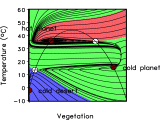 |
||||
| Werner von Bloh
|
|||||
| Animations |
|
||||
All animations are encoded as MPEG-1 movies. They can be played by the Berkeley MPEG player available for Unix/Linux, Mac and Windows. Life in the Earth system is not simply adapted to fixed or prescribed environmental conditions. The biosphere actually influences and controls, to a considerable extent, the setting for its own evolution. This uncontested insight is echoed by the much-debated "Gaia Hypothesis", which speculates about self-stabilizing capabilities of the "planetary super-organism". Whether the hypothesis is correct or not, the underlying geophysiological approach to the explanation of geosphere-biosphere interactions is most valuable and may provide explanations for some puzzling observations. A particularly useful ansatz for the investigation of geosphere-biosphere feedbacks is the Lovelock-Watson model (LWM) of "Daisyworld". Despite its toy character, this model sheds much light on possible mechanisms of environment stabilization through evolutionary adaptation of terrestrial vegetation to varying insolation. Even more insights can be gained if the simple LWM is replaced by a 2D cellular automaton version, which takes into account a number of additional physical (e.g., lateral heat flow) and biological (e.g., competition and mutation) processes reflecting the interacting elements within the real Earth system. It can be found find that spatial heat transport and mutation even improve the self-regulation abilities of the model biosphere. As a matter of fact, in the limit of infinite system size, a first-order phase transition from optimum ambient conditions to a non-habitable environment will take place. The existence of a phase transition implies accompanying hysteretic effects, i.e., points of no return. The animation (MPEG-1 (15 MByte), WMV (4 Mbyte)) shows the evolution of the temperature and albedo of this artificial planet under increasing and decreasing solar luminosity. More about geophysiological modelling and Daisyworld can be found here. Minimal model of the climate-vegetation interaction According to the "virtual biosphere" concept the contemporary Earth biosphere is one of many possible (multiple) biospheres corresponding to the multiple equilibria of some nonlinear dynamic system. This is demonstrated by a minimal model of the climate-vegetation interaction. It consists of two coupled nonlinear equations for climate and carbon in the vegetation. Depending on the total amount of carbon in the system, A,, as one of the bifurcation parameters it exhibits up to three stable equilibria. The animation (3 Mbyte) shows the so-called phase portrait of the minimal system for decreasing bifurcation parameter A. More details about the model can be found here. |
|||||
|
|
|||||
| Impressum © PIK 2006 |

